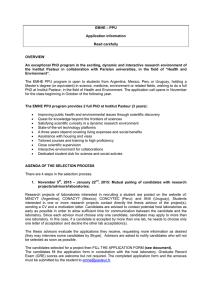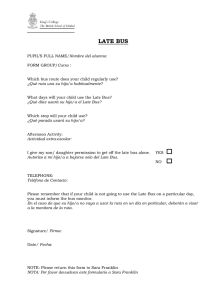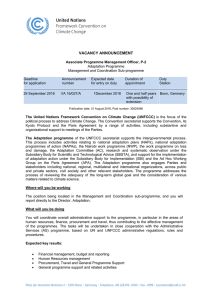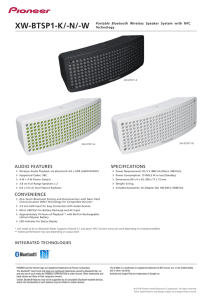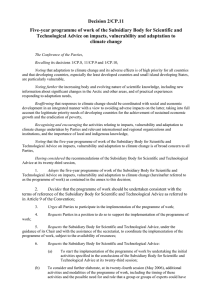UCare: Context-Aware Services for Disabled Users in Urban
Anuncio
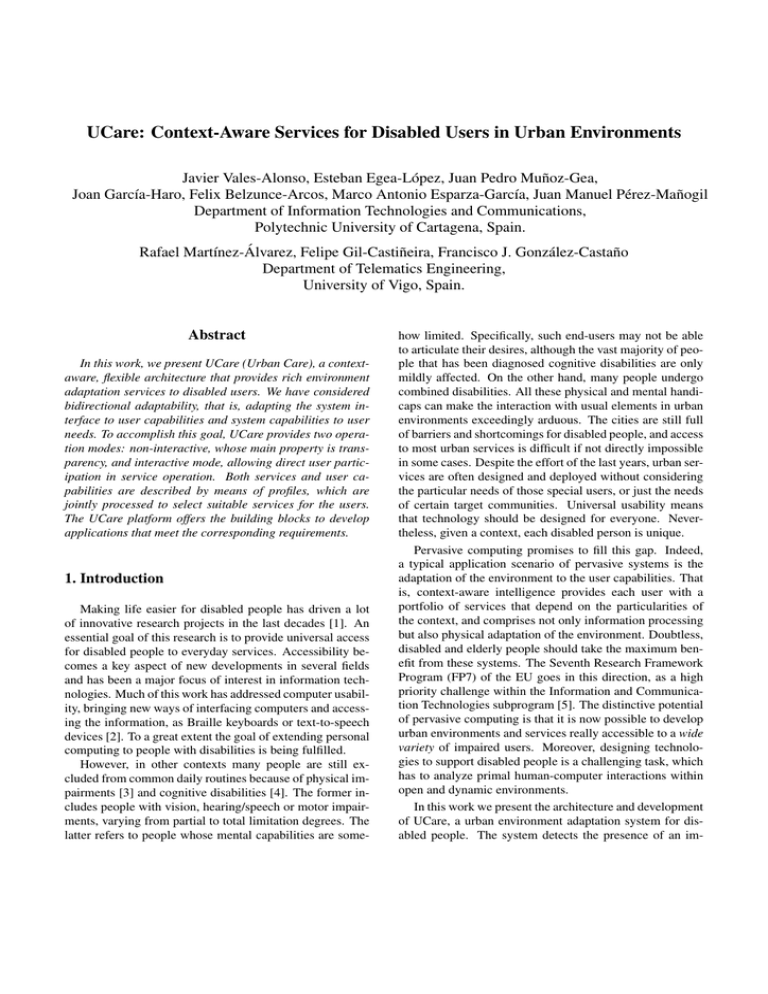
UCare: Context-Aware Services for Disabled Users in Urban Environments Javier Vales-Alonso, Esteban Egea-López, Juan Pedro Muñoz-Gea, Joan Garcı́a-Haro, Felix Belzunce-Arcos, Marco Antonio Esparza-Garcı́a, Juan Manuel Pérez-Mañogil Department of Information Technologies and Communications, Polytechnic University of Cartagena, Spain. Rafael Martı́nez-Álvarez, Felipe Gil-Castiñeira, Francisco J. González-Castaño Department of Telematics Engineering, University of Vigo, Spain. Abstract In this work, we present UCare (Urban Care), a contextaware, flexible architecture that provides rich environment adaptation services to disabled users. We have considered bidirectional adaptability, that is, adapting the system interface to user capabilities and system capabilities to user needs. To accomplish this goal, UCare provides two operation modes: non-interactive, whose main property is transparency, and interactive mode, allowing direct user participation in service operation. Both services and user capabilities are described by means of profiles, which are jointly processed to select suitable services for the users. The UCare platform offers the building blocks to develop applications that meet the corresponding requirements. 1. Introduction Making life easier for disabled people has driven a lot of innovative research projects in the last decades [1]. An essential goal of this research is to provide universal access for disabled people to everyday services. Accessibility becomes a key aspect of new developments in several fields and has been a major focus of interest in information technologies. Much of this work has addressed computer usability, bringing new ways of interfacing computers and accessing the information, as Braille keyboards or text-to-speech devices [2]. To a great extent the goal of extending personal computing to people with disabilities is being fulfilled. However, in other contexts many people are still excluded from common daily routines because of physical impairments [3] and cognitive disabilities [4]. The former includes people with vision, hearing/speech or motor impairments, varying from partial to total limitation degrees. The latter refers to people whose mental capabilities are some- how limited. Specifically, such end-users may not be able to articulate their desires, although the vast majority of people that has been diagnosed cognitive disabilities are only mildly affected. On the other hand, many people undergo combined disabilities. All these physical and mental handicaps can make the interaction with usual elements in urban environments exceedingly arduous. The cities are still full of barriers and shortcomings for disabled people, and access to most urban services is difficult if not directly impossible in some cases. Despite the effort of the last years, urban services are often designed and deployed without considering the particular needs of those special users, or just the needs of certain target communities. Universal usability means that technology should be designed for everyone. Nevertheless, given a context, each disabled person is unique. Pervasive computing promises to fill this gap. Indeed, a typical application scenario of pervasive systems is the adaptation of the environment to the user capabilities. That is, context-aware intelligence provides each user with a portfolio of services that depend on the particularities of the context, and comprises not only information processing but also physical adaptation of the environment. Doubtless, disabled and elderly people should take the maximum benefit from these systems. The Seventh Research Framework Program (FP7) of the EU goes in this direction, as a high priority challenge within the Information and Communication Technologies subprogram [5]. The distinctive potential of pervasive computing is that it is now possible to develop urban environments and services really accessible to a wide variety of impaired users. Moreover, designing technologies to support disabled people is a challenging task, which has to analyze primal human-computer interactions within open and dynamic environments. In this work we present the architecture and development of UCare, a urban environment adaptation system for disabled people. The system detects the presence of an im- paired user and either adapts the environment to him/her or facilitates his/her interaction with a given service. Our design goals are achieving adaptability to a wide range of disabilities, keeping it as transparent as possible to the user, and employing readily available technologies. To meet these requirements we have designed a flexible profilebased system leveraging smart phone technology. We discuss here all these features and the security and privacy of the system, which is crucial for the sake of feasibility. Although we have first focused on urban services adaptation, the system architecture can be extended to help disabled people in other scenarios or as a platform for delivering general, user-adapted services. The rest of this paper is organized as follows: In Section 2, we present the motivation of this work. In section 3 we describe some building blocks for the architecture in section 4. In section 5 we present our first prototype. Section 6 discusses the support of final applications. We have deliberately moved the analysis of related work to Section 7, for a better understanding of our contributions. Section 8 concludes the paper. 2. Urban services for disabled people and interactivity There are many usual situations that illustrate the difficulties and annoyances for impaired citizens: vision impaired people waiting in a bus stop cannot know when their bus is approaching, they still have to hold a big card with the number of the bus they wish to stop. The same may need to estimate the position of pressing buttons of traffic lights. And even the action of pressing the button may be very difficult for people with heavy motor and coordination impairments (who, in addition, need enough time to cross the street). Obviously, all these hindrances severely affect these people in their daily interaction with urban services. Let us see how an adaptation system enhances accessibility in the previous examples: the blind person in the bus stop example is detected by the desired bus and its driver is informed; when the bus stops, a message is received by the user. In a more advanced scenario, the bus stop itself provides the user with information about the buses, their destinations, frequencies and expected arrival times. The user then just selects the desired bus and waits for its arrival. In the case of the motor impaired user, the traffic lights also detect his/her presence and schedule a crossing interval, appropriately adjusting the time. There are many possible adaptations, which can be classified in two main modes of operation: • Non-interactive. In this mode, the system automatically adapts itself to user needs without his/her participation. The traffic lights adaptation and basic bus stop notification are examples of such a system. The main advantage of this mode is transparency, in the sense that the user does not have to explicitly operate any part of the system. Although there has been a great deal of work on computer usability for disabled people, it is still difficult for many users to interact with their devices. Therefore, the system helps the user to seamlessly cope with urban environment and services. It relieves the user from as many (unnecessary) tasks as possible. As a bonus, users do not require specific training. • Interactive. Nevertheless, for some services it is more interesting to let the user interact with the service. For instance, in the advanced bus stop scenario, from the information the bus stop provides, the user may select the bus according to its frequency or expected arrival time. Another example is an automated teller machine (ATM) exporting its interface to the user device. For a blind user, the ATM sends the information to build an interface in an appropriate format for the user (e.g. speech and Braille). With this mode, the variety of possible services is richer at the cost of more complexity in the interface and more effort in the user side. However, this effort is relative, since, as in the previous case, users do not need additional training, since they employ the interface they are accustomed to. Our goal has been to design a transparent system to a user deciding so, yet flexible enough to accommodate interactivity and richer services. The key issue to achieve both goals is a smart usage and management of profiles as we will discuss later. 3. Smart phones and profiles Although there are several devices that enable the pervasive computing paradigm such as ambient displays or wearable computers, they are still expensive and not widely available. Smart phones, on the contrary, offer a shortterm solution that is readily available, and they are usually referred as the first-choice platform to pervasive computing [6]. Smart phones and PDAs (whose boundary is nowadays blurred) are relatively low cost devices, provide a wide range of connectivity possibilities (WiFi, Bluetooth, infrared and cellular communications), have relatively high processing capabilities and open operating systems and are widely adopted. All these features have motivated us to choose smart phones and PDAs as system components. Another major requirement of UCare is the possibility to handle a wide range of disabilities. Therefore, our system relies on profiles, key components to achieve universal accessibility. These Profiles allow the system to adapt to the specific needs, wishes and capabilities of different more wireless interfaces (RI). This device carries a user profile, a device profile and one or more service profiles. • Profile Processing Unit (PPU). It processes the user profiles and performs the required actions by means of the adaptation units. This device is installed in the service points, that is, it is attached to traffic lights, bus stops, buses or taxis. It typically carries diverse wireless interfaces (RI) to serve the corresponding interface types to the user units • Adaptation Units (AU). Electronic or mechanical devices that perform the actions the user requires, driven by the PPU. Figure 1. UCare architecture users. They carry the information that describe user impairments and their preferences regarding specific services. XML (eXtended Meta Language) is the natural format to store and process this information in order to promote device interoperation. We have defined three different types of XML-based profiles: (1) user profile, which contains information about the user impairment; (2) user and system device profile, which stores information about devices capabilities and offered services and (3) service profile, which contains information about the preferences of the user regarding a certain service. The design we propose combines the profiles as follows: at the system side, user and device profiles produce a set of services for a given impairment, which include a list of service configuration options. This service profile is jointly processed at the user side with the user profile to render the options in a proper user format. That is, the smart phone interface dynamically includes the options provided by the service, as in other application fields [7]. The user can then refine the service and return the preferences to the system in order to perform the adaptation. With this organization, we may extend the system capabilities and services in the future. It also allows interactive and non-interactive applications. In many cases, interactivity is a user choice, that is, there is no need of active user participation unless she/he decides to personalize the service. 4. Architecture Figure 1 shows the main blocks of the UCare architecture: • Radio Interfaces (RI). The wireless interfaces available. These devices enable wireless communications and provide service and user discovery. • User Unit (UU). A smart phone or PDA with one or • Sensoring Units (SU). An interface with a sensing system that provides additional context information. A wide variety of context information systems belong to this block. For instance, the sensing units may range from a simple application using RSSI (Radio Signal Strength Indication) to estimate the user distance to the PPU to a complex RFID (Radio Frequency Identification) subsystem that tracks buses passing near a bus stop. The system architecture is general in order to accommodate a wide variety of services. We have also followed this philosophy for system operation, which is depicted in Fig. 2: 1. Service discovery. During this phase, the UUs and PPUs detect each other. From a general point of view, user detection may be performed by periodic PPU beacon messages. However, a better approach is to leverage the capabilities of current wireless technologies: Bluetooth already provides this service, as WiFi does if the PPU WiFi interface is configured as an access point. Therefore, user and service discovery is delegated to the RIs. 2. Service negotiation. After establishing a connection, the UU and the PPU start a profile exchange protocol. The user and PPU device profiles are combined to generate a service profile with default options. This is sent to the UU, which either automatically modifies the option values and returns the profile or requests a direct user selection. The PPU uses the modified user profile to configure the service. 3. Service provision. This phase comprises several tasks. On one hand, the service may require additional context information . Thus, the PPU retrieves that information from the SUs and, if necessary, keeps checking the context while the service is being provided; for instance, the PPU tracks user presence or position. On the other hand, different concurrent profiles are possible. In this case, the PPU includes a resolution module that decides which actions should be performed according to the different profiles received. In case of contradictory actions, the PPU takes a decision according to an action priority scheme. All these processes result in the activation of the corresponding AUs. 4. Service finalization. Once the service has been provided, the PPU and the AUs recover their original or default state. This general operation mainly enables a user detection and profile exchange process suitable for a wide range of scenarios. The applications in the PPU and the UU that implement the services are the real core of the system. However, this simple approach still allows a quick development of many services, as shown in the following Sections. 4.1. Service negotiation The configuration and adaptation of the service to different users needs takes place during the service negotiation phase, and according to the information stored in the three profile types: • User profile. Stores the type and degree of impairment. It is carried by the UU. • Device profile. Both the PPU and the UU carry a device profile. The PPU profile device stores each available action for a given type and degree of impairment. In addition, each action has a list of available configuration options, with a default value and a text description associated. The UU device profile stores information related to special capabilities of the UU, like for instance the availability of text-to-speech applications. • Service profile. These are ad-hoc profiles the PPU generates. They store a generic definition of the service with the list of associated actions and default options. The profile exchange protocol works as follows: first, the UU sends the user profile using the wireless interface. When the PPU receives the user profile it searches for the user impairment type and degree in its device profile. If there is a match, a service profile is generated and the available actions are added to it, together with the associated combination of options-default values. This profile is sent to the UU. After receiving it, the UU looks if there are settings for the indicated generic service. We consider three possibilities at the moment: (1) default behavior, (2) user decision, or (3) unknown service. In the former case, the UU automatically sends the service profile back to the PPU. Otherwise, the service profile is processed together with the Figure 2. UCare operation UU device profile to inform the user about the options in an appropriate format. For instance, if the user is blind and the device profile indicates that there is a text-to-speech application, the text description and values of the options in the service profile are announced. There are sophisticate techniques to automatically generate an appropriate user interface [7]. Finally, the service profile is filled with the user choices and sent back to the PPU. In addition, for each new discovered service, the UU stores the generic service settings. Finally, the PPU uses the returned information in the service profile to perform the service provision phase. This design is flexible enough to provide new services or extend them without UU updates. If there are new actions for a service, they are included in the service profile and the user gets informed. If a new service is available, the user is also informed and may establish the corresponding default settings for the future. In addition, interactivity is optional, which keeps the system as transparent as possible, while providing enough flexibility for advanced services. 4.2. Security User privacy and data security aspects of pervasive computing raise serious concerns. In our field, these concerns are even more justified, since we provide a system for public environments that uses personal information related to health and disabilities. Obviously, this information must be handled with extreme care and confidentiality. . We have considered two main privacy and security requirements: • A user is never willing to publicly providing his/her personal data. There must exist some means to authenticate the PPU and encrypt the communications between the UU and the PPU. • The system, in its turn, should not offer services to fake users. As in the previous case, users must demonstrate that they are legitimate ones. To achieve these requirements we decided to implement a security layer based on public key authentication. Users and PPUs hold pairs of private/public keys created with RSA or DSA. The authentication of the parties is performed by a challenge-response algorithm [8]. This procedure is effective as long as it is supported by a reliable third party, an authorized public/private institution, which must authenticate and sign the public keys of all the entities. Once the parties have authenticated each other, the data are encrypted using the corresponding public keys. Note that this procedure can be implemented directly with SSL (Secure Sockets Layer). 4.3. Suitability Let us finally discuss the features that make this architecture particularly suitable as an adaptation system for disabled people: • We have considered bidirectional adaptability, that is, adapting the system interface to user capabilities and system capabilities to user needs. The UCare architecture offers the building blocks to develop applications that meet this requirement. • The proposed profile processing and refinement procedure allows developing interactive and non-interactive applications. In the former case, the user would interact with a familiar interface (a Perkins Braille keyboard, for instance), enhancing accessibility to the service. In the latter case, the adaptation is transparent to the user, but he/she has the option to personalize it. • It uses currently available commodity technologies and it is easily scalable, since is based on local information exchanges. Both aspects may contribute to its adoption, since it makes feasible the deployment of medium-size prototypes for testing purposes. 5. Prototype As a proof-of-concept of our approach we have developed a prototype for non-interactive applications. It is a traffic lights adaptation system capable of: • Activating audible signals for blind people. • Extending the time to cross for motor-disabled users. We have defined two user profiles: vision and motor impairment (with different degrees). The available options for the actions are their mere activation (default) or not. The resolution module just decides to perform one of the actions or them both if necessary. The crossing interval is set according to the degree of motor or vision impairment, as reported by the user. The prototype comprises the following modules (see Fig. 3): • Bluetooth User Unit: a Sony Ericsson P800 mobile phone with Symbian O.S. 2.0. • WiFi User Unit: an iPAQ 5500 PDA with Familiar Linux 0.8.2. • Profile Processing Unit: a SB-X255 Compulab single board computer with Debian Linux and WiFi and Bluetooth interfaces. • Adaptation Unit: traffic lights with audible signals emulator (a PCB with a loudspeaker and three led diodes that represent the traffic lights). This circuit is controlled by the computer through the parallel interface • Sensoring Unit: it is simply a user presence tracker implemented by software, as we will describe. With this prototype we can test the main user units (smart phones and PDA) and communication technologies (WiFi and Bluetooth). We take advantage of the RI functionalities to implement service discovery: regarding Bluetooth, we have defined a new Bluetooth “UCare” profile, and we have used the standard service discovery protocol (SDP). The applications in the PPU and the UU are registered with SDP and they start the service negotiation phase after the discovery. Regarding WiFi, we have configured the PPU as an access point, and the application listens at a given port. Thus, when the UU (the PDA) discovers a new network, it automatically sends a HELLO message to that port, which the PPU replies. Afterwards, the security handshake is performed (parties authentication) and every subsequent negotiation exchange is encrypted. In order to minimize the information losses and enhance reliability (Bluetooth and WiFi use the same ISM free band, prone to interference), we decided to use connection oriented protocols, that is, TCP for WiFi and RFCOMM for Bluetooth. SSL provides the security layer with server and client authentication. Once service negotiation has finished, the PPU starts a simple user presence tracker (SU) to ensure that the user really wants to cross and is close to the traffic lights. It is just a basic keep-alive protocol: the PPU periodically sends a (a) Prototype components (b) Experimental setup Figure 3. Prototype description beacon (a random number), which the UU replies. In addition, we wanted to test if a keep-alive function is useful in a general sense, as we will discuss later. The PPU has been implemented in the SB-X255 board with three independent C-programmed processes, interconnected by local sockets: the communication server process, the XML processor, and the resolution-decision process. The communication server is in charge of detecting UU presence and managing communications: it receives the HELLO messages and the user profile from the UU, dispatches it to the XML processor and detects when the UU leaves the coverage area. The XML processor handles profile management completely. Finally, the resolutiondecision process receives the actions required from the XML processor, applies concurrent profile resolution rules, and activates the adaptation unit. There are no inconsistencies: in case of concurrent profiles, the crossing interval for the highest degree of impairment is selected. 5.1. Tests and results After checking the correct operation of the system, we were particularly interested in coverage (radio range) measurements. The influence of this parameter on system performance varies depending on the service. For instance, for a traffic lights adaptation service, a short radio range is needed, in order to activate the service when the user is close to the crossing. However, for a bus stop notification service, long ranges are preferable, in order to inform the bus driver with enough time. In fact, without additional context information, this parameter drives an important aspect of adaptation systems: timely service provision. We found out that there are two different radio ranges that have influence on the system performance: actual cov- erage radio of wireless interfaces (R) and service radio (Rs ). A user that reaches R is actually within PPU radio coverage, but, since the UU RI is not continuously scanning the channel (to prevent battery consumption), there is a delay until the service is active. We checked that average Bluetooth coverage (R) and service (Rs ) are 10 and 3 meters respectively, whereas WiFi coverage (R) is 30 meters (shorter than typical due to the PDA radiation pattern) and service radio (Rs ) is around 15 meters. In fact, these values depend on the scanning interval and the user speed, which may be configured attending to specific service criteria. For instance, in the traffic lights example, the service must only start if the user stays close to the traffic-light for some given time, to prevent casual users nearby to interfere with traffic conditions (this may be particularly harmful in the WiFi case, due to its extended coverage). Moreover, this implementation of a presence tracker introduces undesirable coupling between SU and UU application implementation, that is, the SU should be able to track users independently, without conditioning UU implementations. Therefore, we conclude that a richer context information is needed, even for simple applications like the one we have implemented in our prototype. Namely, we need SUs that provide information such as accurate user or cars position and speed. More complex applications would require more sophisticate SUs. 6. Applications The work we present in this paper is our first step towards a system with richer services. We have developed and tested the basic building blocks: a procedure to organize, exchange and process information related to user handicap, device capabilities and service preferences. Several services Non-Interactive Interactive Information Access Larger fonts in displays, high-contrast colors, automatic text-to-speech messages, computer self-configuration Adapted information on the UU, usual user interface, selection of preferred information media Navigation Taxi/bus stop notification Bus/train route selection, stores/services localization Payments - Transactions acknowledgement. Payment information is available to the user through the UU Computer/console self-configuration, text-tospeech signals in museums and monuments UU as a simple interface for game selections. Leisure Signaling Notification of obstacles, traffic lights adaptation Elevators/doors control via UU interface, ATM machines and similar command via UU interface indoor guiding, Table 1. UCare service classification and possible adaptation examples can be offered by developing the appropriate applications on top of the basic infrastructure. Table 1 summarizes the possibilities of the applications we have in mind. All these possibilities follow the same behavioral pattern. Non-interactive applications would receive a user profile and reply with a generic service profile. The UU would then return back a pre-configured service profile without user participation. The pre-configured service profile would be filled: (1) At the general configuration stage. For instance, when the user receives the UU terminal, he/she can select preferences about fonts or colors, default time to cross streets, etc. Or (2) the first time the service is discovered. These applications would mainly use presence trackers as SU, in order to keep the service active until the user has left. Interactive applications would use the refined service profile with the options selected by the user. Depending on the service, diverse profile exchanges may be possible. In this case, we consider an additional profile type: a service status profile to store information related to on-going transactions. Besides, each service requires the correct SU. For instance, indoor guiding requires information about user position. To sum up, and as previously mentioned, the actual core of the advanced services will be the applications on the PPU, but the UCare architecture facilitates incremental development from a firm staring point, as well as a structured framework. 7. Related work In this Section we summarize projects related to smart environments for disabled people and provide a brief overview of the technologies they are using. We have classified them according to the following categories: 1. Interactive systems. 2. Non-interactive systems. 3. Profile-based systems. 4. Non profile-based systems. 7.1. Interactive, non profile-based systems Indoor Navigation [10] assists blind users to orientate themselves in indoor environments. The system uses a sensor module that can be handled like a flashlight by a blind user. It can be used for searching tasks within a threedimensional environment. By pressing keys, inquiries concerning object characteristics, position, orientation and navigation can be sent to a portable computer, or to a federation of data servers providing models of the environment. While this project focuses on a particular environment which is completely described in the servers, our system does not intend to describe the environment, but to provide service adaptation for disabled people with minimal intervention by the user. The Chatty Environment [11] is an ubiquitous computing system designed to help blind and visually impaired people to enhance visual information around. Objects are tagged with electronic markers (such as RFID Tags) which are detectable by the mobile user device at some adjustable distance. Every unique ID is resolved (via WiFi) at a web server returning a highly dynamic and up-to-date XML file. The user can then navigate over a set of active objects in a tree data model with several depth levels. Related information is announced by a commercial text-to-speech engine installed on the device. 7.2. Interactive, profile-based systems The SAID project [12] aims at developing social assistance infrastructure to provide more efficient social care for elderly people, improving accessibility to information sources. SAID supports a number of services over a Digital TV infrastructure. For the elderly, SAID implements a mixed computer/personal based environment where the individual will be given the opportunity of self care, with the possibility of 24-hours aid when needed. SAID provides disabled and elderly people with Internet information that can be automatically filtered or prioritized according to a user profile. That is, unlike our system, the SAID project focuses on human-computer interaction for elderly people. 7.3. Non-interactive, non profile-based systems The Mobilthon project [13] helps myopathy patients in their daily lives. The safety system includes sensors discretely integrated into the clothing of the person. These sensors detect falls and sudden or unusual body leanings. They are linked by Bluetooth technology to a cell phone, which can signal a hazardous situation to a predefined list of people. Drishti [14] is a wireless pedestrian navigation system. It integrates several technologies including wearable computers, voice recognition and synthesis, wireless networks, Geographic Information System (GIS) and Global Positioning System (GPS). Drishti augments contextual information for the visually impaired. It computes optimized routes based on temporal constraints (e.g traffic congestion) and dynamic obstacles (e.g. ongoing ground work). The system constantly guides the blind user according to static and dynamic data. It provides on-the-fly environmental conditions and landmark information, queried from a spatial database along the route, through voice cues with detailed explanations. Our system is, to some extent, complementary, because it facilitates the movement of impaired people along their routes. 7.4. Non-interactive, profile-based systems P-ITS [9] is a pedestrian-centered traffic system based on ubiquitous and wearable computing techniques. It fo- cuses on safer and more comfortable environments for blind pedestrians. The system is based on terminals located on the streets and wearable computers. These two types of terminals communicate with each other via short range wireless communications such as Bluetooth. The street terminals and the wearable computers exchange their data. The wearable computer drives the user considering its own information and that from the street terminals. On its turn, the street terminal changes traffic infrastructure, such as traffic lights, according to the information supplied by neighboring wearable computers. This way, P-ITS can be configured to provide services that create a smooth and comfortable environment for pedestrians. Although it is conceptually similar to our system, P-ITS is a much more ambitious project with a long-term perspective, since it leverages on wearable computers and distributed sensors in the city. On the contrary, our system is currently feasible and practical, and its base technology is widely available. OntoNav [15] is an integrated indoor navigation system. It is user-centric, that is, the routes are given to the user depending on his/her physical and perception capabilities, specific preferences, and current location. This system focuses on the configuration and selection of the best possible route for a person with a particular profile, for that person to store the route in his PDA for example. 8. Conclusions Adapting services to disabled users poses a challenge: how to cope with the huge variety of user needs. The variety of user problems leads to a wide range of possible services, with increasing complexity, sophistication and interactivity. Thus, rather than providing specific services we decided to focus on an architecture that would allow us to incrementally extend the capabilities. Our first step has been to test our approach with a noninteractive adaptation service. Its performance is conditioned by the wireless effective radio coverage, and the presence tracker we developed as a sensing unit has proven to be limited. Even such a simple service needs more refined context information in order to provide a practical service. Indeed, most applications require timely service provision. We are developing appropriate sensing units for the UCare platform, as well as a complete bus planning and information service to test interactive applications. In any case, our main efforts are now focused on getting feedback from everyday experience of disabled users and let them evaluate the system. Human-computer interaction is also a main concern that we plan to address in future work. 9. Acknowledgments This work has been funded by Ministerio de Educación y Cien- cia/Spain grant “Sistemas de inteligencia ambiental para asistencia a deportistas con perfiles especificos” DEP2006-56158-C0301/03, grant CON-PARTE-1 TEC2007-67966-01/TC and Ministerio de Industria/Spain grant “m:Ciudad” (FIT-330503-2006-2) (partially funded by the European Regional Development Fund, ERFD). It has been developed with the support of “Programa de Ayudas a Grupos de Excelencia de la Región de Murcia”, Fundación Séneca, CARM, PRCT 2007/2010. [11] Coroama, V. “Experiences from the Design of a Ubiquitous Computing System for the Blind”. Adjunct Proc. of Conference on Human Factors in Computing Systems (CHI 2006), 2006. References [13] Mobilthon Project. [Online]. Available at: http://www.francetelecom.com/sirius/rd/en/ ddm/en/technologies/ddm200309/techfiche3.php [1] Cook, A. M., Hussey, S. M. Assistive Technologies, 2nd Edition. C. V. Mosby, 2002. [2] ACM Special Interest Group on Accessible Computing. http://www.acm.org/sigaccess [3] Kitchin, R. “ ‘Out of place’, ‘Knowing One’s Place’: space, power and the exclusion of disabled people”. Routledge Disability and Society, vol. 13(3), pp. 343– 356, 1998. [4] Carmien, S., Dawe, M., Fischer, G., Gorman, A., Kintsch, A., Sullivan, J. “Socio-Technical Environments Supporting People with Cognitive Disabilities Using Public Transportation”. ACM Transactions on Computer-Human Interaction, vol. 12(2), pp. 233– 262, 2005. [5] European Commission. “Work Programme 20072008. Information and Communication Technologies”. ftp://ftp.cordis.lu/pub/fp7/ict/docs/ict-wp-200708 en.pdf [6] Roussos, G., Marsh, A. J., Maglavera, S. “Enabling Pervasive Computing with Smart Phones”. IEEE Pervasive Computing, vol. 4(2), pp. 20–27, 2005. [7] Nichols, J., Mayers, B. A. “Controlling Home and Office Appliances with Smart Phones”. IEEE Pervasive Computing, vol. 5(3), pp. 60–67, 2006. [8] Kurose F. J., Ross W. K. Computer Networking. Pearson Education, 2004. [9] Sasaki, H., Tateishi, T., Kuroda, T., Manabe,Y., Chihara, K. “Wearable Computer for the Blind Aiming at a Pedestrians’ Intelligent Transport System”. Proc. Third Int. Conf. on Disability, Virtual Reality and Associated Technologies, pp. 235–241, 2000. [10] Hub, A., Diepstraten, J., Ertl, T. “Design and Development of an Indoor Navigation and Object Identification System for the Blind”. Proc. of ACM ASSETS, pp. 147–152, 2004. [12] Zinnikus, I., Bogdanovich, A., Schfer, R. “An Ontology Based Recommendation System for Elderly and Disabled Persons”. Workshop Adaptability and User Modeling in Interactive Systems (ABIS 2002), 2002. [14] Helal, A., Moore, S.E., Ramachandran, B. “Drishti: an Integrated Navigation System for Visually Impaired and Disabled”. Proc. Fifth International Symposium on Wearable Computers, pp. 149–156, 2001. [15] Anagnostopoulos, C., Tsetsos, V., Kikiras, P., Hadjiefthymiades, S. “OntoNav: A Semantic Indoor Navigation System”. First Workshop Semantics in Mobile Environments (SME05), 2005.
